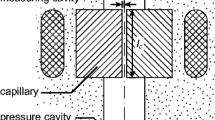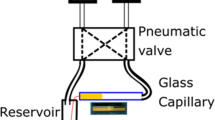Abstract
Capillary rheometry provides an efficient access to high shear rate flow properties relevant for processing. An automated gas driven capillary rheometer developed at BASF enables accurate measurements at imposed wall shear stress, thus supplementing instruments operating at imposed flow rate. A simplified treatment of dissipative heating based on the assumption of a radially flat temperature profile is outlined and justified by means of finite element simulations. The combined treatment of dissipation and pressure dependent viscosity yields relations to treat throttling experiments at imposed flow rate. Throttle pressure coefficients from a long die and an orifice agree for LDPE but significantly differ for PαMSAN. The effect is explained on the basis of identical pressure coefficients for shear and elongational flows, with regard to a constant stress, however. The effect of melt compressibility is negligible in practical capillary rheometry if the temperature and pressure coefficients of the melt density are by an order of magnitude smaller than those of the viscosity. Gas pressure driven instruments allow an effective determination of wall slip velocities from Mooney plots. This is of advantage for the investigation of the mechanism of additives or processing aids. Furthermore, imposed pressure experiments are pertinent to investigate the spurt effect of HDPE and to demonstrate that two different slip processes contribute to the apparent flow curve above spurt.



















Similar content being viewed by others
Notes
For simplicity, the temperature increase at the die wall, which may be monitored by thermocouples located near the die wall, was neglected to avoid additional parameters in the simulation. This is justified because the variation of wall temperature is generally small compared to the magnitude of temperature changes in the melt.
References
Amos SE, Giacoletto GM, Horns JH, Lavallée C, Woods SS (2001) In: Plastics additives. Polymer processing aids (PPA). Hanser, Munich
Bagley EB (1956) End corrections in the capillary flow of polyethylene. J Appl Phys 28:624–627
Binding DM, Couch MA, Walters K (1998) The pressure dependence of the shear and elongational properties of polymer melts. J Non-Newtonian Fluid Mech 79:137–155
Chakravorty S, Rides M, Allen CRG, Brown CS (1996) Polymer melt viscosity increases under pressure: simple new measurement method. Plast Rubber Compos Proc Appl 25:260–261j
Cogswell FN (1977) Stretching flow instabilities at the exits of extrusion dies. J Non-Newtonian Fluid Mech 2:37–47
Cox HW, Macosko CW (1974) Viscous dissipation in die flows. AIChE J 29:785–795
Denn MM (1981) Pressure drop-flow rate equation for adiabatic capillary flow with a pressure- and temperature-dependent viscosity. Polym Eng Sci 21:65–68
Denn MM (1990) Issues in viscoelastic fluid mechanics. Ann Rev Fluid Mech 22:13–34
Denn MM (2001) Extrusion instabilities and wall slip. Ann Rev Fluid Mech 33:265–297
Eisenschitz R, Rabinowitch B Weissenberg K (1929) Dsch Mat-Prüf-Anst Sonderheft 9:91
El Kissi N, Piau JM, Toussaint F (1997) Sharkskin and cracking of polymer melt extrudates. J Non-Newtonian Fluid Mech 68:271–290
Gleissle W (1994a) Influence of the measuring apparatus and method on the value of the melt index. Rheology 94:13–22
Gleissle W (1994b) Influence of the viscoelastic functions on the melt index. Rheology 94:138–147
Goubert A, Vermant J, Moldenaers P, Göttfert A, Ernst B (2001) Comparison of measurement techniques for evaluating the pressure dependence of the viscosity. Appl Rheol 11:26–37
Hatzikiriakos SG, Dealey J (1992) Wall slip of molten high-density polyethylenes. 2. Capillary rheometer studies. J Non-Newtonian Fluid Mech 36:703–741
Hatzikiriakos SG, Hong P, Ho W, Stuart CW (1995) The effect of Teflon coatings in polyethylene capillary extrusion. J Appl Polym Sci 55:595–603
Hay G, Mackay ME, Awati KM, Park Y (1999) Pressure and temperature effects in slit rheometry. J Rheol 43:1099–1116
Inn YW, Fischer RJ, Shaw MT (1998) Visual observation of development of sharkskin melt fracture in polybutadiene extrusion. Rheol Acta 37:573–582
Laun HM (1983) Polymer melt rheology with a slit die. Rheol Acta 22:171–185
Laun HM (1989) New laboratory tests to measure rheological properties of paper coatings in transient and steady-state flows. Rheol Acta 28:267–280
Laun HM (1996) Wall slip of polymer melts. Experimental characterization and relevance for processing. Proceedings of PPS-12, Sorento, pp 31–34
Laun HM (1998) Rheological and mechanical properties of PαMSAN/PMMA blends in miscible and phase separated regimes. I. Characterization of constituents, blend preparation, and overview on blend morphology. Pure Appl Chem 70:1547–1566
Laun HM (2003) Pressure dependent viscosity and dissipative heating in capillary rheometry of polymer melts. Rheol Acta 42:295–308
Meissner J (1963) The effect of temperature on the flow properties of the LDPE melt. Proceedings of the 4th International Congress on Rheology, Providence, Part 3. Interscience Publishers, pp 437–453
Meissner J (1967) Untersuchungen über das Fließverhalten von geschmolzenem Polyethylen mit dem Kapillarviskosimeter. Materialprüfung 5:107–113
Meissner J (1975) Basic parameters, melt rheology, processing and end-use properties of three similar low density polyethylene samples. Pure Appl Chem 47:551–612
Migler KB, Son Y, Qiao F, Flynn K (2002) Extensional deformation, cohesive failure, and boundary conditions during sharkskin melt fracture. J Rheol 46:383–400
Mooney M (1931) Explicit formulas for slip and fluidity. Trans Soc Rheol 2:210–222
Shore JD, Ronis D, Piché L, Grant M (1997) Theory of melt fracture instabilities in the capillary flow of polymer melts. Phys Rev E 55:2976–2992
Uhland E (1979) Das anomale Fließverhalten von Polyäthylen hoher Dichte. Rheol Acta 18:1–24
Waßner E (1998) Strömungsuntersuchungen mit der Laser-Doppler-Anemometrie bei der Extrusion von Polyethylenschmelzen. Dissertation Erlangen 1998, Shaker, Aachen)
Winter HH (1975) Temperature fields in extruder dies with circular, annular, or slit cross-section. Polym Eng Sci 15:84–89
Winter HH (1977) Viscous dissipation in shear flows of molten polymers. Adv Heat Transfer 13:205–266
Acknowledgements
The author is indebted to Wolfgang Reuther for the design and installation of the automated nitrogen gas capillary rheometer ANCR as well as the example measurements. Peter Schuler is thanked for the design of the throttling tool for the Rheograph 2000 and the corresponding tests. The FEM simulations of temperature fields by Gerhard Schmidt using POLYFLOW are gratefully acknowledged. Dr. Ingolf Hennig is thanked for the pVT data.
Author information
Authors and Affiliations
Corresponding author
Rights and permissions
About this article
Cite this article
Laun, H.M. Capillary rheometry for polymer melts revisited. Rheol Acta 43, 509–528 (2004). https://doi.org/10.1007/s00397-004-0387-2
Received:
Accepted:
Published:
Issue Date:
DOI: https://doi.org/10.1007/s00397-004-0387-2





